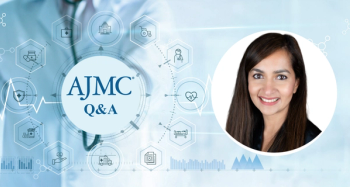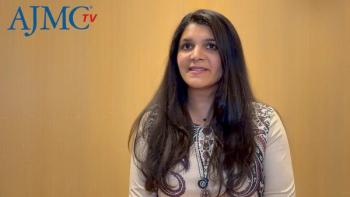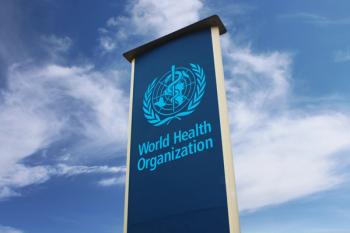
- June 2025
- Volume 31
- Issue Spec. No. 7
- Pages: SP421-SP423
Optimizing Advanced Cancer Therapies and Addressing Logistical, Financial Challenges
Key Takeaways
- CAR T-cell therapy and bispecific antibodies require balancing cost, patient care, and treatment strategies for multiple myeloma and lymphoma.
- Academic-community partnerships can expand access to clinical trials, especially for underserved populations, enhancing patient care.
Coverage from IVBM Cleveland, held May 15, 2025.
Operationalizing chimeric antigen receptor (CAR) T-cell therapy and bispecific antibodies for treating multiple myeloma and lymphoma requires managing an intricate balance of cost-effectiveness, patient care delivery, and emerging treatment strategies, according to panelists at an Institute for Value-Based Medicine (IVBM) event presented by The American Journal of Managed Care in Cleveland, Ohio.
Nathan Denlinger, DO, MS, hematology specialist at The Ohio State University Comprehensive Cancer Center – Arthur G. James Cancer Hospital and Richard J. Solove Research Institute (OSUCCC – James), moderated the discussion with:
- Beth Faiman, PhD, MSN, APN-BC, AOCN, BMTCN, nurse practitioner in the Multiple Myeloma Program at Cleveland Clinic
- Brooke Peters, PharmD, BCOP, associate director of pharmacy at American Oncology Network
- Don Benson, MD, PhD, professor of medicine and director of the myeloma program at The Ohio State University
- Faiz Anwer, MD, hematologist/oncologist at Cleveland Clinic
Complex economics must be considered when treating multiple myeloma. A 4-drug regimen could cost $600,000 annually, whereas a CAR T-cell therapy may be a $500,000 one-time cost,1,2 which raises questions about optimal timing, explained Faiman. Bispecific antibodies are an option for later-stage patients, but they present their own cost considerations. “I’m thinking about the direct cost of the drug itself, indirect costs, loss of work, caregiver absenteeism, that sort of thing, as well as hospitalizations, [and emergency department] visits,” she said.
There is also a shift in how patients with multiple myeloma are categorized, noted Anwer. In addition to classifying patients as transplant eligible or ineligible, patients are identified as eligible or not for the 4-drug combinations. With a large number of treatment options available for relapsed patients, cost becomes an important consideration, as do the adverse effects and other aspects of treatment that could impact quality of life.
Benson echoed the idea that personal preferences will heavily influence treatment decisions, especially when choosing between therapies like bispecifics or CAR T. For patients who want to stay close to home, a bispecific might be the way to go. Peters added that some community providers are not able to offer CAR T-cell therapy, and patients might not have the financial means to travel to an academic center and pay for lodging or have a readily available caregiver to receive a CAR T.
The lack of a caregiver can be a sticking point in the lymphoma space, Denlinger said. Patients need to have someone looking after them with an eye on neurotoxicity, and if they do not have that, they are not eligible to receive CAR T-cell therapy. Other than that, he rarely sees any patients who are ineligible for CAR T based on patient comorbidity because the toxicity profile is “pretty light.”
“You’d be shocked,” he said. “We treat 80-year-olds. We’ve treated patients that are 90 [years old] and above; patients with renal failure, heart failure, other issues, and they’ve gone through [treatment] very well.”
Anwer added that disease dynamics also drive the decision on who gets the CAR T first instead of a bispecific. “There are some patients, they have such an aggressive relapse that it makes sense to just admit them and start on a bispecific antibody,” he said. “There are some patients, they just have a biochemical relapse, and now CAR T for myeloma, in the first-line setting, they’re approved.”
Logistically, CAR T has a longer timeline and is not as readily available in the community, but bispecifics have their own challenges, Faiman said. Although bispecifics are an off-the-shelf product, the practice must have Risk Evaluation Management certification and tocilizumab on hand if the patient develops cytokine release syndrome.
“That’s where the academic and community collaboration can be so rich between the academic center that can maybe give the first few doses of bispecifics and then coordinate with the community or do an earlier CAR T…that’s after 1 prior line of therapy,” she said.
Some patients, Anwer said, have gone through multiple relapses, have aggressive disease, and should be treated with a CAR T-cell therapy. However, he said, they could be treated with a bispecific as a bridging therapy for a few weeks, followed by the CAR T when the cells are ready for infusion.
Reimbursement is also a challenge. Faiman explained that Cleveland Clinic’s standard practice is to admit the patient to the hospital for bispecifics, which leads to financial losses in terms of reimbursement. However, other leading cancer centers, such as Emory Winship Cancer Institute, Fred Hutchinson Cancer Center, and Mayo Clinic, utilize innovative outpatient models for bispecific administration. Cleveland Clinic is testing a service3 that incorporates staff physicians, nurse practitioners, and pharmacists to provide a wide variety of services to these patients and manage toxicities of these treatments that Anwer expects will eventually move to an outpatient service.
Leveraging Academic-Community Partnerships
Another IVBM panel discussed how partnerships between academic centers and community practices can expand patient access to clinical trials, especially for underserved populations. “A healthy population is a wealthy population, and if we can get access and care, including clinical trials, to all populations, then we raise all boats, and I don’t think we’ve done a really good job at that,” said Electra Diane Paskett, PhD, MSPH, FAACR, professor and director of the Division of Cancer Prevention and Control in the Department of Internal Medicine at The Ohio State University College of Medicine.
Theodoros Teknos, MD, president and scientific director of the University Hospitals (UH) Seidman Cancer Center, added that trials must be brought to the patients so they do not have to drive 8 or 9 hours when they want to receive care close to home. To make trials more accessible, UH has set up staffed sites closer to where patients live and can also provide travel for patients with limitations.
In addition to getting trials out in the community, Kimberly Bell, RN, MBA, executive administrator of cancer services for the Cleveland Clinic Health System, noted that pharma companies also have to do their part and revise clinical trial enrollment criteria to better fit the population. Some education must also be provided to get people from a population who do not normally participate in clinical trials to start enrolling. “We really have to understand where the patients are, what their needs are, and how to partner with the community to get them to come in and trust us, to allow us to put them on clinical trials,” Bell said.
Building trust and creating effective relationships between community providers and academic medical centers is also crucial. Teknos noted that UH provides community oncologists with access to the latest data and invites them to join tumor boards and education sessions. There is a bidirectional partnership where community providers send patients in for a second opinion, but it is important that the center sends those patients back. “We’ve benefited greatly from surgical oncology referrals and clinical trial referrals, because…we make every effort to send the patient back and respect the community oncologists and their care,” Teknos said.
Improving Early Diagnosis and Screening in NSCLC
Unlike other cancers, where screening rates of eligible patients are as high as 90%, only a small percentage of eligible patients are screened for lung cancer in general, with particularly low rates among never smokers. Asrar Alahmadi, MBBS, MAS-CR, medical oncologist with OSUCCC – James, noted that there are many reasons why screening rates are so low, including that the people who need the screening the most usually do not receive it due to factors such as their low socioeconomic status, living in a rural area, Medicaid coverage, and being from certain marginalized groups.
Lukas Delasos, DO, a medical oncologist in the thoracic oncology program at Cleveland Clinic, added that access to primary care is another issue. “As a medical oncologist, it’s kind of difficult for us to get involved in those communities, but it’s important for us to spread awareness in those communities,” he said. His colleague at Cleveland Clinic, Emily Cheng, PharmD, BCOP, an oncology clinical pharmacy specialist, added that community awareness and engagement are important because patients are often in later stages of the disease by the time of a clinic visit.
Alahmadi also noted the fragmentation of care that makes screening and treatment more difficult for these patients. Many patients are tested in the community, but that testing is incomplete as testing gets more complicated, moving beyond DNA to include RNA and immunohistochemistry. However, insurance does not always cover multiple rounds of testing if the providers decide they need to do another biopsy because the first one did not provide all the answers. “There’s maybe a bigger policy issue that we would like to see more testing being covered, if needed,” she said.
The panel also delved into treatments including the duration of immunotherapy in non–small cell lung cancer (NSCLC) and when treatment might stop. Alahmadi noted there are data that show treatment of only 2 years is not inferior to treatment of more years, and moderator Afshin Dowlati, MD, of UH Seidman Cancer Center and Case Western Reserve University School of Medicine, said he also does not go beyond 2 years.
Collaboration With Pharmacists
The final panel of the night discussed strategies for optimizing outpatient delivery of bispecifics and CAR T-cell therapies to improve access and reduce costs, highlighting the integration of pharmacists, physicians, and nurses in outpatient CAR T care and the need for multidisciplinary teams to ensure safe and effective outpatient bispecific treatment.
The speakers noted that they are challenged by different payer restrictions or mandates that can fragment care, and there are different strategies to mitigate them. Mitchell Blewett, PharmD, MS, BCPS, oncology pharmacy manager at Cleveland Clinic, noted that a few times a week one of the first emails he gets that day is around site of care denial and the instructions that the patient has to receive care in a physician office or an infusion center that is not connected to a hospital or through home care, which creates new barriers to care.
This creates a need for education among all provider teams to be aware of potential challenges and how to communicate changes in treatment delivery to patients or if the team is going to fight the decision with the payer, although he noted they have had very limited success with that. “We really try to partner with our prior authorization team…trying to get ahead of these things, and being able to get referrals submitted as early as possible, that if we’re getting this denial from the insurance company that we have time to reach out to the patient, coordinate, and figure out if this is something that they’re going to be able to handle,” Blewett said.
Patricia A. Roberts, PharmD, MS, BCPS, BCSCP, director of pharmacy for oncology services at UH, added that these scenarios break up the treatment plan for patients and may add to the cost of care for the patient. She likened trying to adapt to new payer strategies to a game of “Whack-a-Mole.” She also gave the example that sometimes the site of care only applies to 1 drug in the regimen, so the patient can get their conventional chemotherapy at one location but their biologic has to be given at another.
“That’s extremely confusing for the patient,” Roberts said. “It’s not driving value for us either…it’s extremely difficult.”
References
1. Cavallo J. How to treat patients with multiple myeloma cost-effectively without compromising outcome: a conversation with S. Vincent Rajkumar, MD. The ASCO Post. August 25, 2020. Accessed May 28, 2025. https://ascopost.com/issues/august-25-2020/how-to-treat-patients-with-multiple-myeloma-cost-effectively-without-compromising-outcome/
2. Mayer Robinson K. Navigating the financial aspects of CAR T-cell therapy. WebMD. Updated April 24, 2025. Accessed May 28, 2025. https://www.webmd.com/cancer/lymphoma/features/navigate-finances-car-t-cell-therapy
3. New Cellular and Immunotherapy Service provides patients with standard of care and clinical trial opportunities for novel therapies. Cleveland Clinic. August 30, 2024. Accessed May 28, 2025. https://consultqd.clevelandclinic.org/new-cellular-and-immunotherapy-service-provides-patients-with-standard-of-care-and-clinical-trial-opportunities-for-novel-therapies
Articles in this issue
6 months ago
Breast Cancer and the Use of Predictive GenomicsNewsletter
Stay ahead of policy, cost, and value—subscribe to AJMC for expert insights at the intersection of clinical care and health economics.













































